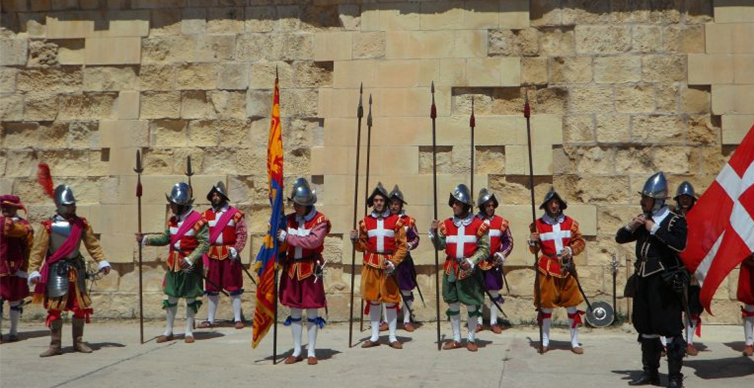Discover the history of Malta!
Overview
| BC | Culture | Description |
|---|
| 5200-4600 | Ghar-Darlam culture | Sicilian farmers colonize the islands |
| 4200-3600 | Zebbug Malta’s culture | believed resettled from Sardinia |
| 3600-3200 | Ggantija Culture | The first stone temples built |
| 3200-3000 | Saflieni-culture | the twin-axle temple construction Hypogeum |
| 3000-2500 | Tarxien culture | completion of the great temples. At the end of the period Malta and Gozo were deserted for unknown reasons |
| 2000-1000 | Bronze Age | Re-colonization from Sicily, the first metal tools and cremations. The enigmatic stone troughs (cart ruts) are formed |
| 700-600 | Ancient Carthage | Originally a Phoenician colony of Malta founded as a commercial and military base |
| 218 | | The Romans defeat Carthage and occupy Malta |
The ancient world
| AD | |
|---|
| 60 | Paul, a disputed interpretation of the Acts of the Apostles, said to have been stranded, on his journey to Rome in the St. Paul’s Bay in Malta and converted the first Maltese Christians. |
| 395 | on the partition of the Roman Empire, Malta was one of the first to join eastern Rome |
| 500-600 | The island belongs to the kingdom of the Vandals and Goths |
| 535 | Through the successful conquest of the commander Belisarius, Malta and southern Italy belong to the Byzantine Empire Emperor Justinian |
The Middle Ages
| AD | |
|---|
| 870 | The Muslim Aghlabids attacked Malta. According to a controversial Arab source, they killed all the inhabitants of the islands and it remained uninhabited for nearly two centuries. |
| 1048 | Re-colonization of Malta and Gozo with 5,000 Muslim and Christian Sicilians. The Arabic-speaking immigrants bring cotton plants, citrus trees and the technology of artificial irrigation. |
| 1127 | Norman Prince Roger III and the Arab governors unite the archipelago of Malta and Sicily. |
| 1194 | The Staufer inherit the Normans in Malta. Under Emperor Frederick III the Muslims of Sicily and Malta are increasingly suppressed. |
| 1282 | The now largely Christianized islands belong with Sicily to the Kingdom of Aragon-Catalonia. Sicilian feudal lords operate in Malta and Gozo large cotton plantations. |
| 1397 | Martin, King of Aragon, recognizes the Università, the self-administration of the Maltese nobility. |
| 1428 | Alfonso V places the islands directly under the Crown. |
| By 1479 | the union of the kingdoms of Aragon and Castile, Malta is part of the Spanish Empire |
Early Modern Era
| AD | |
|---|
| After 1530 | the Knights of St. John of Jerusalem were driven from Rhodes by the Turks, Charles V gives Malta as a fief. The island was developed into a bulwark of the West against the Islamic conquerors. Website of the Order of Malta |
| 1551 | Ottoman pirates ravage and de-populate Gozo (The Gozitans were kidnapped as slaves) |
| 1565 | the great siege by the Turks was repulsed and the Turks driven out after long and intense fighting. In the ensuing year, the Grand Master de la Valette started building a modern capital city Valletta, Europe’s oldest “city drawing board” |
| 1574 | Opening of the Sacra Infirmiera. With the modern hospital the Knights continue in their origin as helpers for the sick pilgrims in the Holy Land. |
| 1641 | Last Ottoman attack. With the proceeds from the piracy and the land ownership in Europe the Catholic Order pays for the elaborate baroque buildings, aqueducts and fortifications. |
| 1798 | Ferdinand of Hompesch, the only Grand Master of German origin capitulated without a fight in front of the fleet of Napoleon. |
The Order of St John in Malta
| AD | |
|---|
| 1800 | Supported by an anti-French revolt of the Maltese population, British troops occupy the island. |
| 1814 | Malta becomes a British crown colony and an important naval base. |
| 1890 | Construction of a railway from Valletta to Rabat (no longer in operation) |
| 1919/1921 | After riots of the poor over a bread tax London granted the country a partial autonomy. The first all-Maltese Parliament is elected. |
| 1940 | The Second World War brought the Maltese a naval blockade by the Axis powers. Heavy air attacks damaged the port of Valletta in particular, this lasted until 1943. |
| 1942 | Malta was awarded by King George VI with the George Cross in gratitude for the resistance during World War II |
Newest developments
| AD | |
|---|
| 1964 | Malta granted independence for the first time, but only within the British Commonwealth. |
| 1974 | Proclamation of the Republic. |
| 1979 | The last British troops leave Malta. |
| 1991 | Malta applies for membership of the EU but application is frozen due to a change to a Labour government. |
| 1998 | After the election victory of the nationalists Malta renews its negotiations with the EU. |
| 2004 | On May 1st, Malta becomes, with 10 other countries, a member of the EU |
| 2008 | On January 1st the € replaces the Maltese pound (lira Maltese) as currency. |

